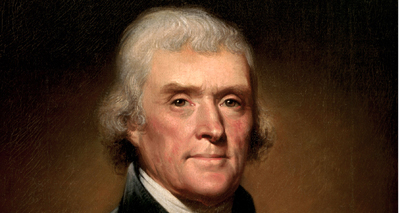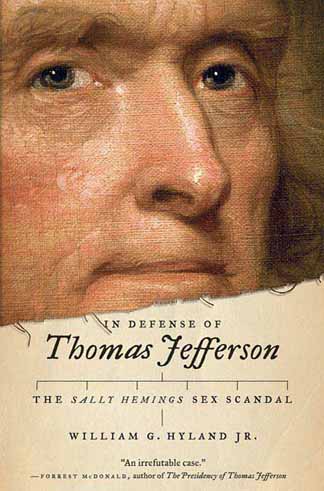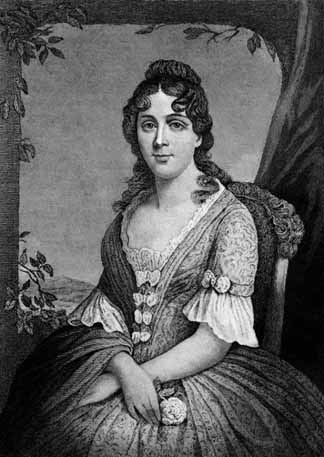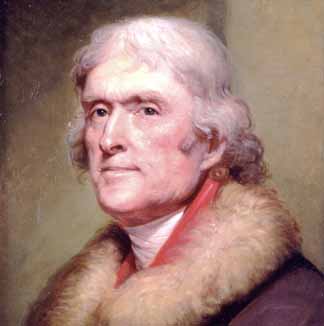Did Jefferson Sleep With His Slave?
Thomas Jackson, American Renaissance, December 7, 2012

On November 30, the New York Times published an op-ed piece by a law professor named Paul Finkelman, who calls Thomas Jefferson “a creepy, brutal hypocrite” because he owned slaves. Prof. Finkelman also takes it for granted that Jefferson had children with his slave Sally Hemings. Jared Taylor has written a response to Prof. Finkelman here.
What follows is a review of an unjustly neglected book that strongly defends the third President against the charge that he slept with his slave.
William G. Hyland, In Defense of Thomas Jefferson: The Sally Hemings Sex Scandal, Thomas Dunne Books, 2009, 292 pp., $26.95.
Nearly every American “knows” that Thomas Jefferson had several children with his slave, Sally Hemings. Nearly everyone “knows” that this has been confirmed by DNA evidence. Lefties even claim that Jefferson raped his slave. In fact, no one “knows” any of this; the evidence for a Hemings affair is unconvincing. If it were not for the ferocious joy the Left takes in believing the worst of the Founding Fathers, the allegations of an affair at Monticello would be a historical footnote.
William Hyland, a practicing lawyer and board member of the Thomas Jefferson Heritage Society, has written an important book that summarizes the evidence on both sides and argues convincingly that Jefferson was not the father of Sally’s children and probably never slept with her. His book is a welcome antidote to the mountains of nonsense that paint the third president as a lecherous old miscegenator.
The muckraker
It was a contemporary of Jefferson’s, a transplanted Scotsman named James Callender, who first spread the accusations about Sally. Callender was a journalist and propagandist who had written so insultingly about British politicians and even the crown that he abandoned his wife and child and escaped to the United States in 1793, one step ahead of the sedition police. He practiced the same vituperative brand of journalism in America, and was convicted in 1800 under the Sedition Act for attacks on President John Adams. Jefferson, who opposed the Federalist sedition laws, defended Callender, and pardoned him on becoming president in 1801. However, when Callender sought the position of postmaster general of Richmond, Virginia, Jefferson found him unfit for office and turned him down.
Callender turned on his benefactor, and in 1802 started writing about Jefferson’s sex life. He claimed Jefferson had sired a son with “dusky Sally,” a “wooly-headed concubine,” who was part of his “Congo harem.” Callender wrote that Sally was a “slut common as the pavement,” who was “romping with half a dozen black fellows,” and had serviced “fifteen or thirty gallants of all colours.” Federalist newspapers opposed to Jefferson’s policies circulated these stories with some effect, and Callender may have been right to claim that he had done more harm to Jefferson’s reputation in five months than all his other critics had done in ten years.
Callender never claimed to have met “dusky Sally” or any of her children, nor did he ever explain how he got his information. Naturally, many people thought he made it up. John Adams — whom Callender called a “hideous hermaphroditical character who has neither the force and firmness of a man, nor the gentleness and sensibility of a woman” — wrote of him: “I believe nothing Callender said. … I would not convict a dog of killing sheep upon the testimony of two such witnesses.” Abigail Adams called him “a libeler whom you could not but detest and despise.” James Madison distrusted him, writing that “it is impossible to reason concerning a man, whose imagination and passions have been so fermented.” In 1803, Callender drowned in two or three feet of water in the James River, reportedly too drunk to fish himself out.
Oral traditions
The only other source for the Jefferson paternity allegations is a sketchy set of claims made by Hemings’ descendants. In 1872, 37 years after Sally’s death and 46 years after Jefferson’s, one of Sally’s younger sons, Madison Hemings, gave an interview to a newspaper editor named S. F. Wetmore, in which he claimed that Jefferson was the father of all six of Sally’s known children. The interview, which is presented as a verbatim transcription, is in flowery language that seems entirely out of keeping with the vocabulary of an ex-slave, and closely follows the Callender version, even including the mistaken spelling of Jefferson’s father-in-law’s name that Callender used in his own account. Mr. Hyland notes that there is no other record of Madison ever having claimed to be descended from Jefferson. Wetmore had a political interest in besmirching Jefferson’s reputation and may well have sought Madison out and encouraged him to claim he had an illustrious father.
The other paternity claim was by Thomas Woodson, a somewhat mysterious black who claimed to be the son that resulted when Jefferson impregnated Sally when she was only 15 or so. This is a particularly improbable claim, since Jefferson kept detailed records of all births to his slaves, and there is no record of a child named Thomas or of a birth to Sally at about that time. Woodson’s claim has also been disproven by DNA evidence, but this has not stopped his descendants from claiming to this day that Jefferson was the father.
DNA
In the late 1990s, DNA testing was carried out to see if the paternity of the Hemings children could be proven. The study was based on the fact that the Y chromosome, carried by all men, is passed intact along the male line, and is detectably different in different families. If Jefferson had fathered Sally’s children, the male-line descendents of her sons would have the Jefferson Y chromosome.
Male-line descendants of the dubious Thomas Woodson and of Sally’s last child, Eston Hemings, agreed to be tested. Interestingly, the descendants of Madison Hemings, the son who gave the Wetmore interview, refused to be tested. The results were announced with great fanfare in the November 5, 1998 issue of the British magazine Nature. First, as noted above, Thomas Woodson’s claim was bogus: There was no Jefferson Y in his male line.
It was the other finding that got all the attention: Eston Hemings carried the Jefferson Y chromosome. On the strength of this, Nature titled its article “Jefferson Fathered Slave’s Last Child,” but the editors knew this was deceptive. They knew that all male-line Jeffersons, including Thomas’s brothers and their sons, carried the Jefferson Y and were equally likely, from a genetic point of view, to be the father. It was only deep into the article — farther than journalists were likely to go — that Nature conceded this. Subtleties like this, of course, mean nothing to crazed lefties, who have cackled with joy ever since at the idea that Monticello was a miscegenist love-nest.
In fact, there were no fewer than 26 Jefferson men of reproductive age living in Virginia at the time of Eston’s conception, who could theoretically have been the father. As we will see, Thomas is not the most likely candidate.
There are a few other circumstantial arguments that can be made in favor of the love-nest claim. One is that Sally was reportedly light-skinned and attractive. She came to Jefferson as part of his wife’s property, and there were even rumors that his wife’s father was Sally’s father. If that were true, it would mean Sally was Jefferson’s wife’s half-sister.
Another argument is that Jefferson seldom freed slaves, yet he freed Madison and Eston Hemings in his will. Jefferson’s policy was to free slaves who he thought could support themselves, and the Hemings men had learned trades. One would also note that Jefferson did not free Sally, either during his life or in his will.
Finally, it appears that Jefferson was at Monticello at the times when Sally’s children were conceived. However, Monticello was Jefferson’s home, and it stands to reason he was there often. Also, no one knows where Sally was most of the time, and there are notes that indicate she was sometimes living away from Monticello.
So much for the case for paternity. What are the opposing arguments?
First, despite the lefty derision they evoke, there are Jefferson’s views and character. He detested miscegenation, which he considered bad for both races. He also was greatly disturbed by slavery, and abhorred the sexual power masters held over female slaves. These well-publicized views add to the lefties’ glee: They can call Jefferson a hypocrite. However, he was probably the most self-controlled of all American presidents. His motto of conduct was, “When tempted to do anything in secret, ask yourself if you would do it in public; if you would not, be sure it is wrong.” To a remarkable extent, he lived by this standard.
The most lurid tale of fornication — and one Callender promoted — is that Jefferson took up with Sally while he was in Paris as Minister to France, and the 1995 movie Jefferson in Paris is full of amorous sport. This is deliberate provocation. Jefferson lost his wife Martha shortly before leaving for Paris, and was devastated by the loss. He promised on her deathbed that he would never remarry, and left for Paris by himself. Later he sent for his children, and someone in his household chose Sally — only 14 at the time — to be a maid for his nine-year-old daughter Mary. Along with Jefferson’s 15-year-old daughter Martha, the girls traveled to Paris and stopped on the way in London, where they met Abigail Adams. Mrs. Adams wrote that Sally was more child than adult and therefore not a good choice for a maid. Jefferson’s daughters, along with Sally, probably boarded at their school rather than under Jefferson’s roof. Wherever they were living, it is unlikely that Jefferson was carrying on an affair with a 14-year-old slave girl under the noses of his daughters. All the evidence suggests that he was not a very sexual man, and there is no real record that he ever took a lover after his wife’s death.
The charge that Jefferson fathered Eston — the son who did carry the Jefferson Y chromosome — is implausible for different reasons. Eston was born in 1808 and would have been conceived while Jefferson was in his second term. The Callender accusations had been circulating since 1802 and had been repeated with some damaging effect by Jefferson’s enemies. Is it likely that Jefferson would risk justifying those accusations while still in office?
Furthermore, Jefferson would have been 64 at the time of Eston’s conception, and his letters from that period are full of complaints about migraine headaches, arthritis, and intestinal infections. Jefferson lived another 19 years after that but his health was poor. Moreover, after retiring from the presidency in 1809, Jefferson moved back permanently to Monticello, where he would have access to Sally at any time, yet Eston was her last child. In the very unlikely case that Jefferson, as a sickly, often-absent, 64-year-old Chief Executive had fathered Eston, he would presumably have had more children with Sally after he retired. Mr. Hyland notes that Sally survived Jefferson by nine years, but there is no record of her ever claiming that the president was her lover.
As for Madison Hemings, whose descendants refused DNA testing, his conception would have occurred in April 1805. Again, Jefferson was still president and therefore unlikely to do anything to justify accusations of miscegenation. He was present at Monticello for several weeks that month during the final illness and funeral of his daughter Mary. He was grief-stricken by her death, and the house was full of guests and mourners. Would Jefferson have been sporting with a slave concubine at such a time?
As she grew older, Jefferson’s eldest daughter Martha became the de facto mistress of Monticello. Her father always liked to have her and her seven children close, and she would have been at Monticello when Sally’s later children were conceived. She was familiar with everything that happened on the plantation and always vehemently denied the remotest possibility of any kind of impropriety between her father and any slave woman.
Jefferson himself never explicitly denied the Sally rumors, but during his career he faced many accusations, and adopted the policy of not dignifying them with replies. Late in life, however, he did write that of all the many scurrilous things said about him only one was true: that when he was a young bachelor he had made improper advances to the wife of an acquaintance, John Walker. This is an implicit denial of the Sally affair.
Finally, there is the account of a contemporary eye-witness, Jefferson’s plantation overseer, Edmund Bacon. Bacon probably knew better than anyone what went on at Monticello. In an account of his years as Jefferson’s overseer he briefly mentioned the paternity allegations but denied them. He wrote that instead of Jefferson he saw — and here the name is rubbed out of the original manuscript — someone else leaving Sally’s quarters “many a morning” when Bacon “went up to Monticello very early.” His account is difficult to dismiss.
The likely suspect
Who, then, fathered Eston? Like many careful scholars, Mr. Hyland has a prime suspect: the president’s younger brother, Randolph.
Randolph lived only 20 miles away, was often at Monticello, and was probably there at the right time. There still exists a letter from the president inviting Randolph for a visit that would have taken place exactly nine months before Eston was born. At that time he would have been a 51-year-old widower, a far more likely father than the older and ailing president.
Years later, a former Jefferson slave, Isaac, wrote an account of life in the slave quarters. Of Randolph, he wrote, “Old Master’s brother, Mass Randall, was a mighty simple man: used to come out among black people, play the fiddle and dance half the night” — circumstances that could easily lead to dalliance. Isaac’s account says nothing about Thomas taking an interest in slave women, and he was never known to spend his leisure time with slaves.
It is worth noting that at the time of Eston’s conception Randolph had four sons, ages 18 to 26, who would also have carried the Jefferson Y. There is no record of their presence at Monticello at that time, but given the fraternizing habits of their father, it seems unlikely that they always held themselves aloof from slaves either.
Randolph remarried after Eston’s birth and had several sons, so it is clear that he was potent. His new wife is said to have been a domineering woman who did not often let him go back to Monticello. Perhaps she did not want him near Sally.
Finally, the Eston family tradition was that he was descended from a Jefferson “uncle.” Eston would have been of Jefferson’s children’s generation, all of whom referred to Randolph as “Uncle.” This tradition fits the view that the younger brother rather than Thomas was the father.
There are suspected fathers of the other Hemings children. One of Jefferson’s sisters married a man who died at age 30, leaving two sons, Sam and Peter Carr. Jefferson was very fond of the Carr brothers and treated them like his own children. Peter later admitted that both he and Sam had slept with Sally, adding that “the old gentleman had to bear the blame” for their misbehavior. Jefferson’s oldest grandson, Thomas Jefferson Randolph, believed that Jefferson was so indulgent towards the Carr brothers that he would never have suspected them of fornication.
There are a few other arguments and counterarguments to be made on the paternity question, and Mr. Hyland summarizes them well. It should be clear, however, that the case against Jefferson is hardly air-tight, and one would think that the Thomas Jefferson Memorial Foundation, which runs Monticello, would defend the president. Not so. The foundation drew up a committee to look into the allegations and appointed a woman named Dianne Swann-Wright to head it. She is black, and a specialist in slave oral traditions. Not surprisingly, she chose to believe the slave accounts. As one white committee member later complained, Miss Swann-Wright and at least one other member clearly reached their conclusions before they examined the evidence. Guides at Monticello are instructed to say that Jefferson was the father, and the foundation web site says all six of Sally’s known children “are now believed to have been Thomas Jefferson’s.”
Mr. Hyland notes that aside from the fashion for mocking dead white men, the foundation may have another reason for kicking Jefferson’s corpse: money. Promoting Monticello as a secret sex nest is good for business. In the years before the controversy, Monticello was getting about $2 million in contributions every year. After the DNA test, contributions jumped to more than $10 million a year — a sad commentary on how Americans approach their own history.
Journalists and academics took reckless joy in writing Jefferson off as a miscegenating hypocrite. There could be no greater contrast to the exquisite sensitivity with which they protect Martin Luther King, Jr. American newspapers would not mention his record of flagrant plagiarism until the British broke the story, and they have largely kept mum on King’s well-documented philanderings and Communist associations. Some day, whites will be able to look at the past without seeing it through a haze of guilt. Mr. Hyland’s book is an important step in that direction.


















